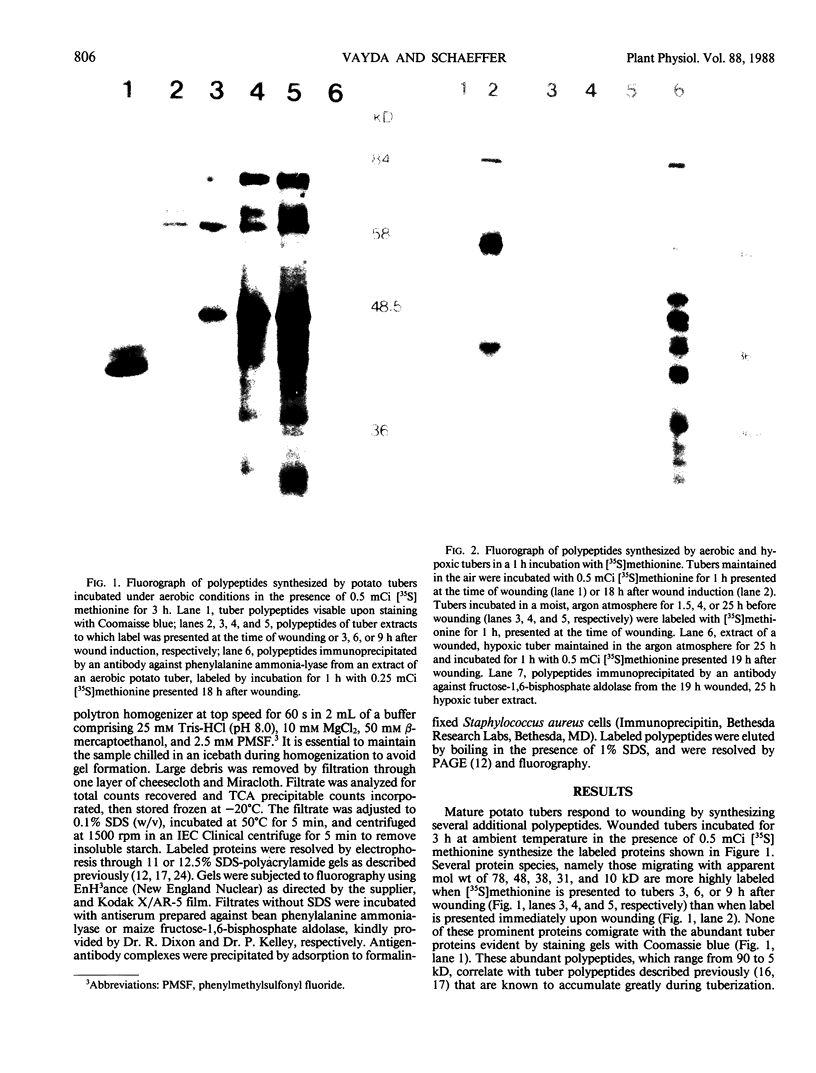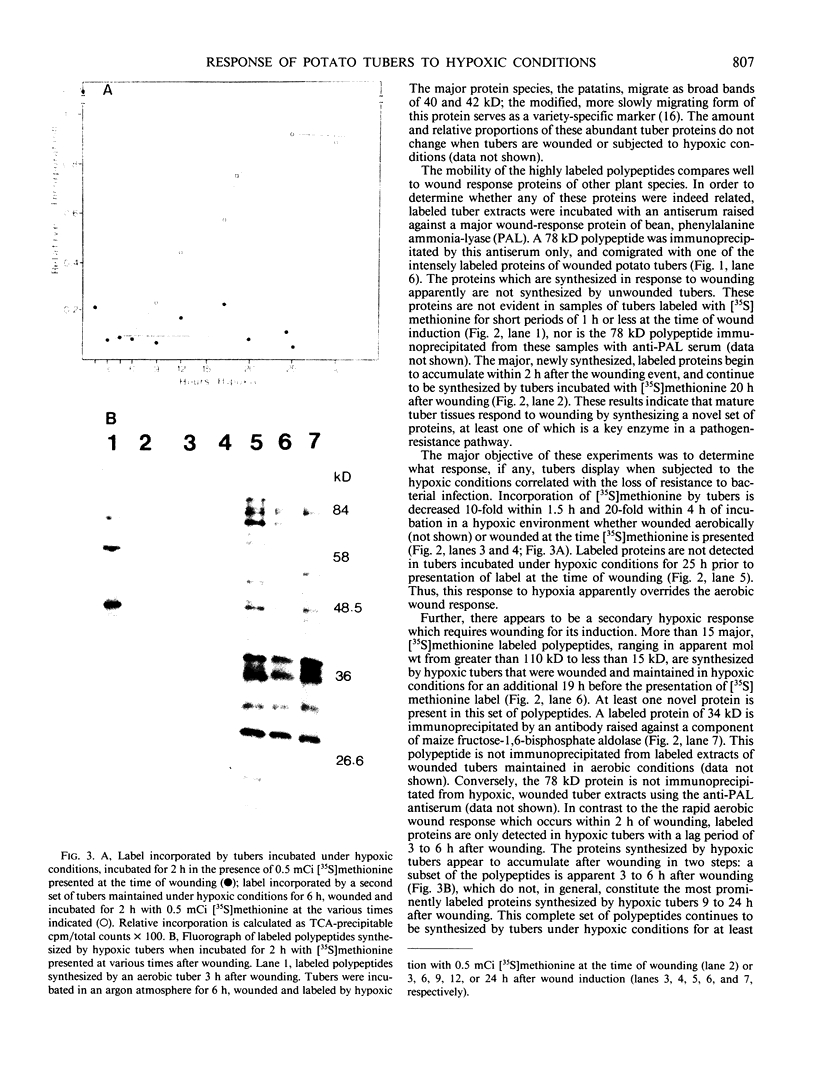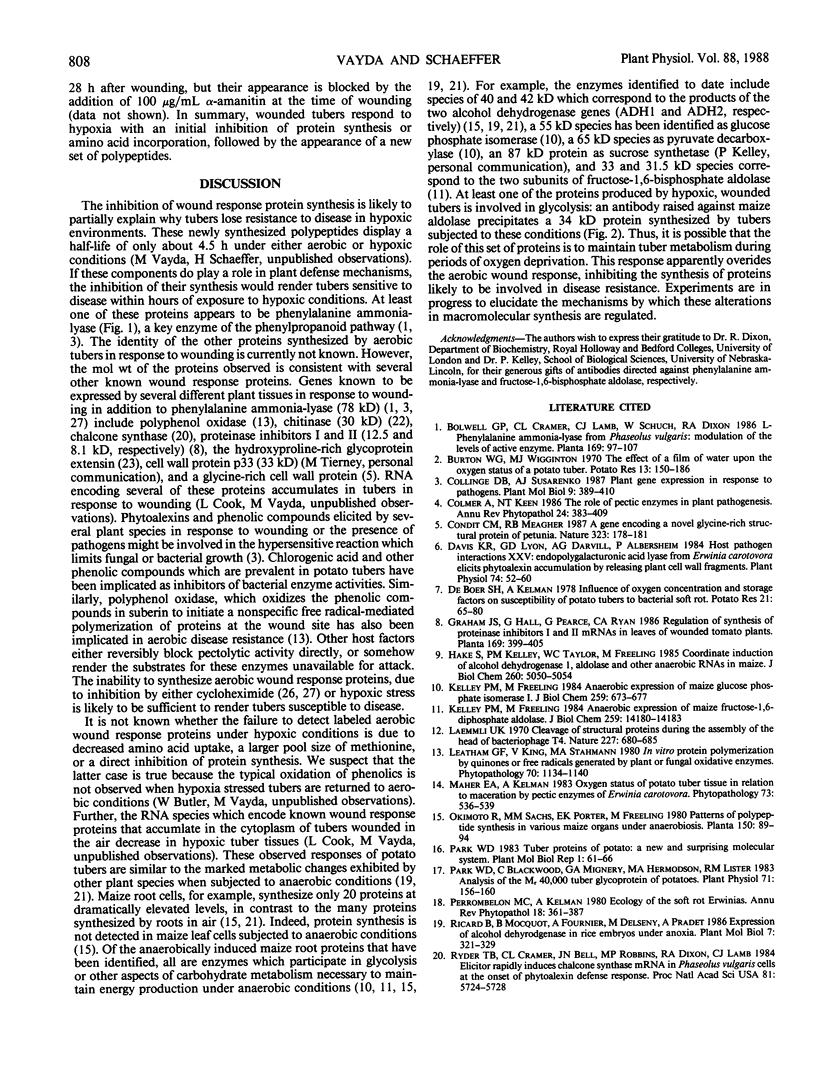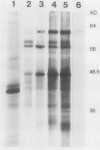Abstract
Potato (Solanum tuberosum L.) tubers respond to environmental stresses by alterations of macromolecular synthesis. In an aerobic environment tubers respond rapidly to wounding by synthesizing a set of proteins, the most prominent of which display apparent molecular weights of 78, 48, 38, and 31 kilodaltons. These proteins become intensely labeled by [35S]methionine within 2 hours of wounding. The 78 kilodalton polypeptide has been identified by immunoprecipitation as phenylalanine ammonia-lyase. By contrast, tubers incubated in hypoxic conditions for a period as short as 1.5 hours exhibit significantly reduced incorporation of amino acids such that newly synthesized polypeptides are not detected. However, a second set of proteins is synthesized by wounded tubers after prolonged incubation in a hypoxic environment. One peptide of this set is precipitated by an antibody directed against aldolase; several of these proteins may be enzymes of glycolysis necessary for anaerobic metabolism. The results indicate that there is a complex regulatory mechanism which allows mature potato tubers to respond to changes in the environment.
Full text
PDF




Images in this article
Selected References
These references are in PubMed. This may not be the complete list of references from this article.
- Davis K. R., Lyon G. D., Darvill A. G., Albersheim P. Host-Pathogen Interactions : XXV. Endopolygalacturonic Acid Lyase from Erwinia carotovora Elicits Phytoalexin Accumulation by Releasing Plant Cell Wall Fragments. Plant Physiol. 1984 Jan;74(1):52–60. doi: 10.1104/pp.74.1.52. [DOI] [PMC free article] [PubMed] [Google Scholar]
- Hake S., Kelley P. M., Taylor W. C., Freeling M. Coordinate induction of alcohol dehydrogenase 1, aldolase, and other anaerobic RNAs in maize. J Biol Chem. 1985 Apr 25;260(8):5050–5054. [PubMed] [Google Scholar]
- Kelley P. M., Freeling M. Anaerobic expression of maize fructose-1,6-diphosphate aldolase. J Biol Chem. 1984 Nov 25;259(22):14180–14183. [PubMed] [Google Scholar]
- Kelley P. M., Freeling M. Anaerobic expression of maize glucose phosphate isomerase I. J Biol Chem. 1984 Jan 10;259(1):673–677. [PubMed] [Google Scholar]
- Laemmli U. K. Cleavage of structural proteins during the assembly of the head of bacteriophage T4. Nature. 1970 Aug 15;227(5259):680–685. doi: 10.1038/227680a0. [DOI] [PubMed] [Google Scholar]
- Park W. D., Blackwood C., Mignery G. A., Hermodson M. A., Lister R. M. Analysis of the Heterogeneity of the 40,000 Molecular Weight Tuber Glycoprotein of Potatoes by Immunological Methods and by NH(2)-Terminal Sequence Analysis. Plant Physiol. 1983 Jan;71(1):156–160. doi: 10.1104/pp.71.1.156. [DOI] [PMC free article] [PubMed] [Google Scholar]
- Ryder T. B., Cramer C. L., Bell J. N., Robbins M. P., Dixon R. A., Lamb C. J. Elicitor rapidly induces chalcone synthase mRNA in Phaseolus vulgaris cells at the onset of the phytoalexin defense response. Proc Natl Acad Sci U S A. 1984 Sep;81(18):5724–5728. doi: 10.1073/pnas.81.18.5724. [DOI] [PMC free article] [PubMed] [Google Scholar]
- Vayda M. E., Rogers A. E., Flint S. J. The structure of nucleoprotein cores released from adenovirions. Nucleic Acids Res. 1983 Jan 25;11(2):441–460. doi: 10.1093/nar/11.2.441. [DOI] [PMC free article] [PubMed] [Google Scholar]





